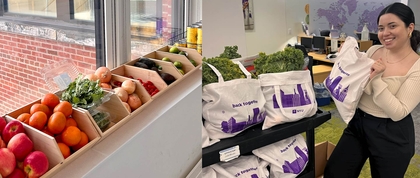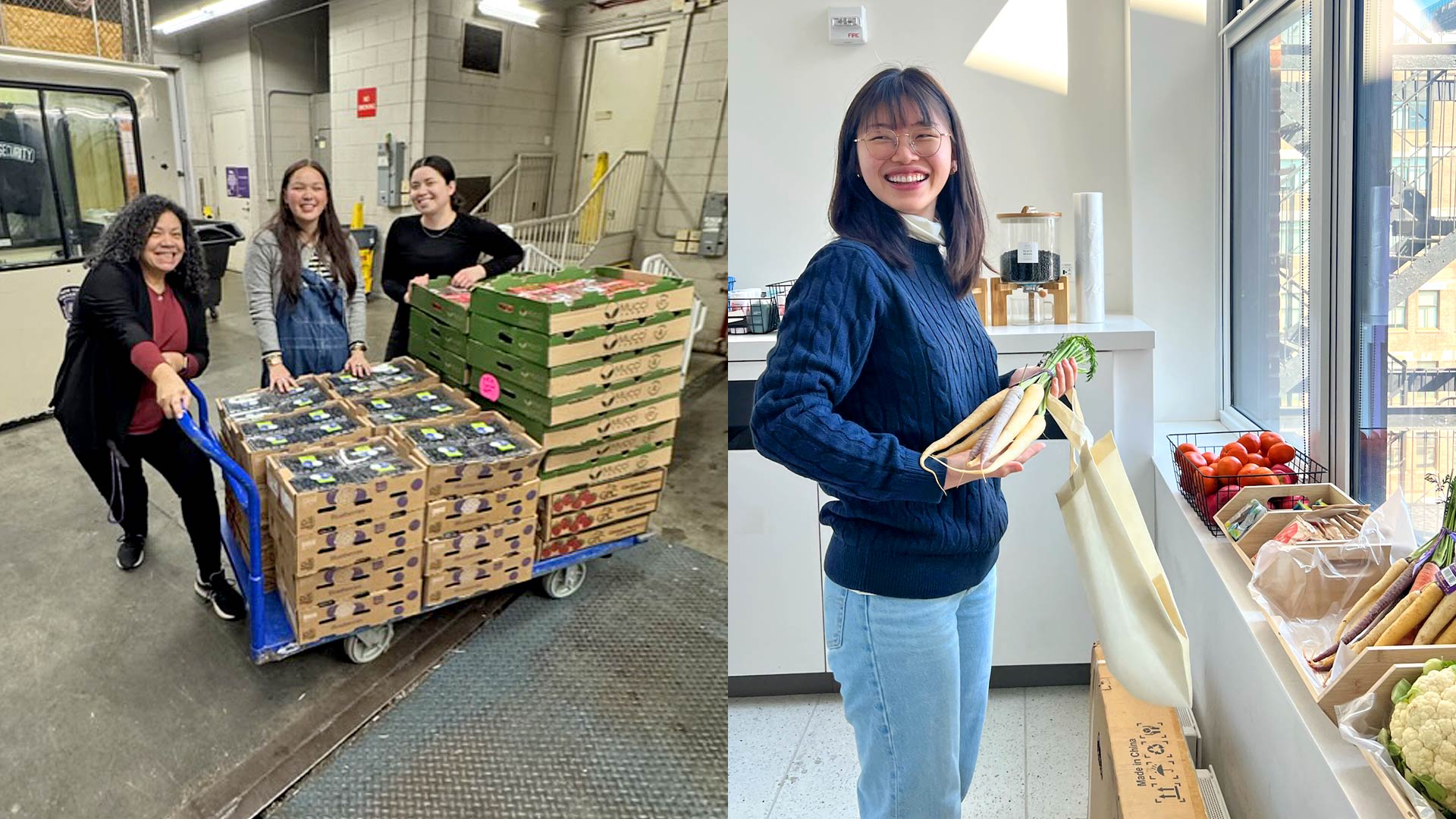
Photo: Example of a weekly GPH Marketplace produce pick-up, featuring ingredients from a featured recipe, (Spring 2025). Elizabeth Gomez, creator of the GPH Marketplace, distributing fresh produce to MPH students, (Fall 2024).
For Elizabeth Gomez, MPH ’25 the path to creating the GPH Marketplace was a culmination of classroom learning, collaboration and real-world problem solving. Driven by a desire for a more sustainable and dignified solution, Elizabeth set out to build something different—a community-centric food pantry that would not only provide nourishment but also challenge the stigma of seeking help. The Marketplace is dedicated to promoting health equity and student wellbeing by expanding access to nutritious food within the GPH and broader NYU community. Through education, advocacy, and action, they empower students to lead efforts that enhance food access and create a supportive environment.
We spoke with Elizabeth about the origin of her idea, and her journey creating the GPH Marketplace.
The Spark of an Idea
In my second year at GPH, I worked as a graduate assistant in the Basic Needs Office, supporting students across NYU who were experiencing financial hardship. Part of that role involved connecting students to existing resources, though it soon became clear that we needed a more comprehensive, sustainable resource to support students, particularly around food access.
Meeting with students and listening to their stories motivated me to take action. From first generation and international students working their way through school with little to no financial support, to students whose lives changed overnight due to sudden family emergencies or other hardships, I saw firsthand how urgent these student’s needs were. I wanted to create a resource that was not only accessible but also supportive.
I saw a path forward by engaging students and faculty, conducting research, and applying for funding through the NYU Student Government Assembly’s (SGA) Initiative Fund. I could create a resource that not only filled the gaps I witnessed but also reflected the values of our School of Global Public Health (GPH). I believed GPH, as a school dedicated to health promotion and health equity, was in a unique position to lead the way, and this idea became the foundation for the creation of the GPH Marketplace.
I wanted the Marketplace to feel welcoming and approachable, and remove the stigma around seeking help. By incorporating fresh produce and other nutritious items, I wanted students to have a positive experience while also addressing students’ immediate nutrition needs.
Lastly, I was thinking about cultural messaging around the “struggling college student.” Often, students are told that financial or food struggles are a normal part of a college experience, which can create a disconnect where some students may not even recognize that they are experiencing food insecurity. As a first-generation Latina student, new to New York, I understood how challenging it can be to navigate resources while balancing school and life stressors. I wanted to challenge that narrative and shift the idea of receiving support into a positive experience rooted in the community at GPH.
Building a Support Network
From early brainstorming to the official launch, I received invaluable support from GPH faculty members. My first step was consulting with professors in the Public Health Nutrition department, whose guidance was invaluable. Dr. Andrea Deierlein, our club advisor, helped shape the initial concept of the Marketplace. Dr. Rachel Ryan played a key role in brainstorming, reviewing multiple drafts of the Marketplace model, and strengthening our intake and data collection systems. Dr. Niyati Parekh met with our club members to explore sustainability, food insecurity, and strategies for being resourceful as graduate students, leaving a lasting impression on how we approached the Marketplace.
On the logistical side, I received tremendous support from staff as well. Alicia Betances, program manager in the Office of Student Affairs, worked closely with me to develop new protocols for ordering and stocking the pantry, while Amanda Garofalo from the Operations team helped establish the infrastructure for students to receive food products and secured dedicated kitchen and storage spaces for us.
Beyond GPH, I also leaned on the broader NYU community. The Violet Pantry within Liberal Studies was an incredible resource. Lacey Campbell and Saylee Nemade welcomed me to shadow their work and shared their expertise in pantry operations. And from my role in the Basic Needs Office, I had the support of Dr. Yvonne Erazo, NYU’s first basic needs support director, whose leadership and vision helped inspire what the Marketplace could become.
Drawing Lessons from the Classroom
My coursework in Public Health Nutrition, particularly with Dr. Deierlein and Dr. Ryan, had a significant influence on how I created the Marketplace. Classes like Public Health Nutrition with Dr. Ryan and Maternal and Child Nutrition in Public Health with Dr. Deierlein reinforced how deeply nutrition impacts long term health and wellbeing, while also helping me understand the realities of how food insecurity and reliance on inexpensive ultra-processed food harms health outcomes. That perspective shaped my goal of not just creating a pantry, but building a resource that prioritized high quality, nutrient dense foods.
Rather than relying heavily on shelf-stable or processed items, I wanted the Marketplace to offer fresh produce and nutritious staples. We designed it so students could pick up ingredients for a featured weekly recipe, developed in collaboration with Public Health Nutrition students. Each recipe was crafted to include a wide variety of nutrients and designed for easy meal prep.

In addition, my courses in Community Health Science, such as Community-Based Health Interventions with Professor Nura Anwar, provided helpful frameworks for program implementation. I learned how to approach this as a structured project and to plan effectively, gather student feedback, and track data to improve operations. In the first 3 months of operation, we built a committed community of 13 Marketplace Collective members and served 350 student users. The opportunity to apply what I was learning in class to a real-world project by combining nutrition knowledge, program planning, and a focus on equity was one of the most rewarding parts of this experience.
Advice for Future Students
Approach any new project like a research question and utilize a program implementation framework to frame your initiative. Start by collecting data and surveying your peers in order to gather as much feedback as possible before launching. This ensures that your program is grounded in real insight and addresses the actual needs of your community rather than being based on assumptions.
I’d also encourage future students to seek out support early. Meet with professors whose expertise aligns with your vision, and connect with the Office of Student Affairs for guidance. Starting a project can feel daunting, but once you begin engaging with your NYU community, you’ll quickly find there are many people who are eager to help.
Entrepreneurial Lessons Learned
One of the biggest lessons I learned from starting the GPH Marketplace is the importance of building relationships and seeking support early. You can’t execute a project alone, and when you’re launching a new initiative, there are always unexpected challenges. From navigating funding and approvals to figuring out logistics and reaching students effectively. I overcame these challenges by leaning on faculty, staff, and building the GPH Marketplace Collective, made up of peers equally as passionate about nutrition and health equity and who volunteered their time at the Marketplace to help ensure the project’s success.
I also learned the value of being open-minded and flexible. While I was initially eager to incorporate many different ideas into the initiative, not every plan worked out exactly as envisioned. Being receptive to feedback and willing to adapt ultimately made the initiative stronger. I realized that even small steps can have a meaningful impact. By starting with a focused, manageable approach, we created a foundation that is poised to grow sustainably over time. I’m very proud of how far the initiative has come and excited to see what it will become in the future.